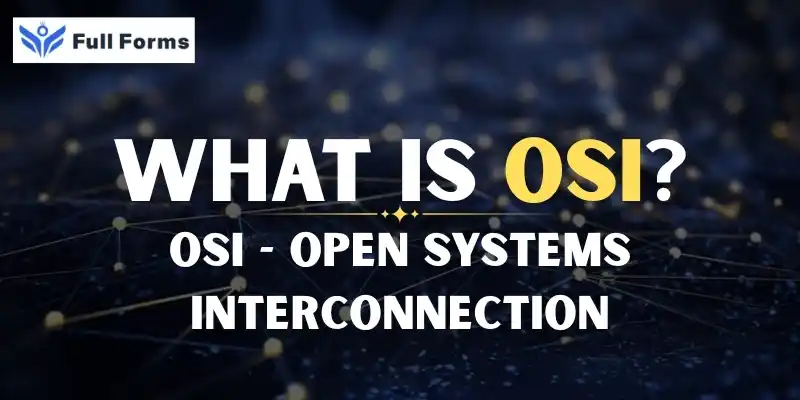Open Systems Interconnection
(OSI)

Description
What does Open Systems Interconnection (OSI) mean?
The OSI Model is a powerful idea that can help you understand how the internet works behind the scenes, like how your message gets from one device to another.
Open Systems Interconnection (OSI) is a way to talk about how computers, phones, and other devices talk to each other over a network.
We'll break down the OSI Model into simple parts, explain why it's important, and show how it works in real life in this article.
What does the OSI Model mean?
The Open Systems Interconnection (OSI) model is a way to explain how data moves between computers on a network. The International Organization for Standardization (ISO) made it so that all systems and devices can talk to each other in the same way, no matter who made them.
There are seven layers in the OSI model, and each one has a different job. These layers work together to send your message, file, or video across the internet or a local network from one place to another.
The OSI Model has seven layers, from the bottom to the top
Let’s look at the layers with a simple example: You send a picture from your phone to a friend over the internet.
1. The Physical Layer
This is the hardware level, which includes wires, cables, switches, and Wi-Fi signals. It sends raw bits (0s and 1s) over the connection. A real-world example is the Wi-Fi signal or network cable that connects your phone to your router.
2. The Data Link Layer
It makes sure that two devices are directly connected without any mistakes. It sorts data into frames and works with MAC (Media Access Control) addresses. An example from real life: your phone's Wi-Fi adapter sending data using your router's MAC address.
3. The Network Layer
This layer is in charge of routing, which is how data moves from one network to another. It finds the best way by looking at IP addresses. In real life, your picture gets an IP address and moves around the internet.
4. Transport Layer
Its job is to break data into small packets, check for mistakes, and make sure the data gets there in the right order. In real life, your phone sends the picture in pieces, and your friend's phone puts it back together.
5. Session Layer
It keeps track of the sessions or connections between devices. It starts, controls, and ends communication between apps. A session is set up between your messaging app and your friend's app in real life.
6. The Presentation Layer
This layer changes the data into a format that both devices can understand. It might be able to encrypt, compress, or change the format of files. For example, your image file is sent after being compressed or encrypted.
7. The Application Layer
This is the layer you can see; it works with the software you're using. For example, your messaging app (like WhatsApp or Telegram) sends and gets the picture.
Why is the OSI Model important?
The OSI model is helpful for:
- Make it possible for different devices and brands to talk to each other in the same way.
- Find out which layer the problem is in to fix network problems.
- Teach people how to use complicated networking systems.
- Make new technologies that work well with the communication systems that are already in place.
The OSI Model in the Real World
Let’s use a real-life example: sending a letter.
- Application: You write the letter.
- Presentation: You write it in a way that the reader can understand.
- Session: You talk to the post office.
- Transport: The letter is divided into envelopes, if needed.
- Network: The letter has an address.
- Data Link: It gets to the right delivery person.
- Physical: The letter goes through roads, cars, and mailboxes.
The OSI Model and the TCP/IP Model
You might also hear about the TCP/IP model, which is what the internet uses to talk to each other. OSI is more theoretical and useful for learning, while TCP/IP is more practical and used every day. But OSI is still very helpful for learning and getting a sense of the big picture.
Interesting Facts about the OSI Model
- It was made in the 1980s, but people still use it to learn and fix things today.
- The OSI model is not a piece of software or hardware; it's a way of thinking about things.
- When IT experts are trying to fix network problems, they often talk about OSI layers (for example, "That's a Layer 3 problem").
Last Thoughts
The Open Systems Interconnection (OSI) model is like a map for how data moves from one place to another. It shows how different parts of a network work together to send information quickly, safely, and smoothly.
You can't see these layers when you use your phone or computer, but they're working quietly in the background to make sure your calls, videos, and emails get to the right place. You will better understand the amazing technology that connects our world if you learn about the OSI model.
